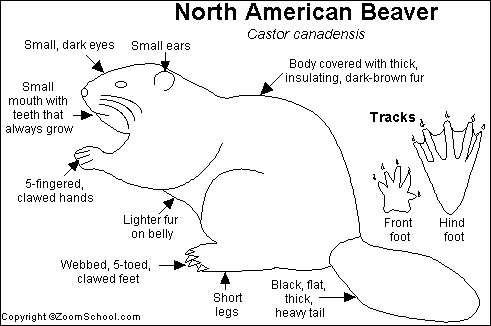|
|
Canku Ota |
|
|
(Many Paths) |
||
|
An Online Newsletter Celebrating Native America |
||
|
June 30, 2001 - Issue 39 |
||
|
|
||
|
Beaver |
||

| The beaver is a large, semi-aquatic rodent with a large, flattened tail. It is a strong swimmer and can swim
up to 5 miles per hour (8 kph). The beaver can swim underwater for up to 15 minutes. Young beavers are called kits.
Beavers live in forests in North America and in parts of Europe and Asia. Beavers do not hibernate over winter,
but they will stay in their lodge, where they have stored enough food to last until spring. Beaver Lodges and Dams: Beavers build sophisticated lodges out of sticks and mud. The dome-shaped lodge is built in water and only has underwater entrances. If the local pond water isn't deep enough, the beaver will build a dam (or a series of dams) downstream from where the beaver wants to build a lodge. The dam forms a deep pond. Beavers cut down trees for the dam using their strong teeth. The water in the pond must be deep enough so that the pond bottom won't freeze in winter, blocking the lodge's entrance. Anatomy: Beavers are about 3 ft (0.9 m) long; their flat, thick tail is about 1 ft (30 cm) long. They weigh 30-70 pounds (14-32 kg). Like all rodents, their teeth continue to grow their entire lives. Their ears and nostrils can close while the beaver is underwater. While swimming, transparent eyelids protect their eyes. Beavers can close their mouth by closing a flap located behind their teeth, allowing them to chew while holding their breath. Diet: Beavers are herbivores (plant-eaters). They eat tree bark, leaves, roots, twigs, and water plants. Predators: The beaver is hunted by many animals, including coyotes, wolves, bears, lynxes, and wolverines. Minks, owls and hawks prey upon young beavers. Beavers cannot move very quickly on land, so their best defense from predators is to retreat into the water and go into their lodge. Copyright ©1999-2001 EnchantedLearning.com |
|
|
||
|
|
||
| Canku Ota is a free Newsletter celebrating Native America, its traditions and accomplishments . We do not provide subscriber or visitor names to anyone. Some articles presented in Canku Ota may contain copyright material. We have received appropriate permissions for republishing any articles. Material appearing here is distributed without profit or monetary gain to those who have expressed an interest. This is in accordance with Title 17 U.S.C. section 107. | ||
|
Canku Ota is a copyright © 2000, 2001 of Vicki Lockard and Paul Barry. |
||
|
|
|
|
|
The "Canku Ota - A Newsletter Celebrating Native America" web site and its design is the |
||
|
Copyright © 1999, 2000, 2001 of Paul C. Barry. |
||
|
All Rights Reserved. |
